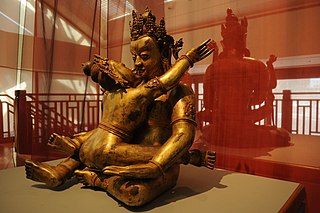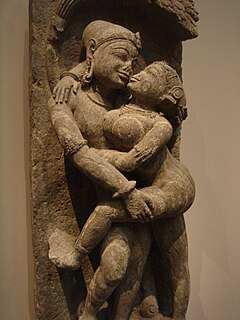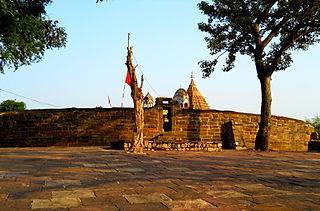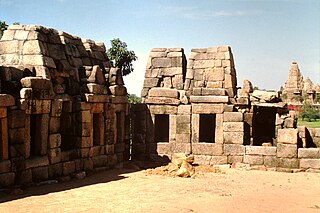
Tantra are the esoteric traditions of Hinduism and Buddhism that developed in India from the middle of the 1st millennium CE onwards. The term tantra, in the Indian traditions, also means any systematic broadly applicable "text, theory, system, method, instrument, technique or practice". A key feature of these traditions is the use of mantras, and thus they are commonly referred to as Mantramārga in Hinduism or Mantrayāna and Guhyamantra in Buddhism.

Vajrayāna along with Mantrayāna, Guhyamantrayāna, Tantrayāna, Secret Mantra, Tantric Buddhism, and Esoteric Buddhism are names referring to Buddhist traditions associated with Tantra and "Secret Mantra," which developed in the medieval Indian subcontinent and spread to Tibet, East Asia, Mongolia and other Himalayan states.

Shaivism is one of the major Hindu traditions that worships Shiva, also called Rudra, as the Supreme Being. One of the largest Hindu denominations, it incorporates many sub-traditions ranging from devotional dualistic theism such as Shaiva Siddhanta to yoga-oriented monistic non-theism such as Kashmiri Shaivism. It considers both the Vedas and the Agama texts as important sources of theology.
Tantras refers to numerous and varied scriptures pertaining to any of several esoteric traditions rooted in Hindu and Buddhist philosophy. The religious culture of the Tantras is essentially Hindu, and Buddhist Tantric material can be shown to have been derived from Hindu sources. And although Hindu and Buddhist Tantra have many similarities from the outside, they do have some clear distinctions. The rest of this article deals with Hindu Tantra. Buddhist Tantras are described in the article on Buddhist Tantras.

Tantric sex or sexual yoga refers to a wide range of practices carried on in Hindu and Buddhist tantra to exercise sexuality in a ritualized or yogic context, often associated with antinomian or impure elements, like consumption of alcohol, and offerings of impure substances like meat to fierce deities. In particular, sexual fluids have been viewed as "power substances" and used ritualistically, either externally or internally.

In Hinduism, the goddess Tara is the second of the Dasa (ten) Mahavidyas or "Great Wisdom goddesses", and is a form of Adishakti, the tantric manifestations of Parvati. Her most famous centre of worship is the temple and the cremation ground of Tarapithin West Bengal, India. Her three most famous forms are Ekajaṭā, Ugratara, and Nīlasarasvatī(pronounced Neel Saraswati in Hindi)

Shaktism is one of several major Hindu denominations, wherein the metaphysical reality is considered metaphorically a woman and Shakti (Mahadevi) is regarded as the supreme godhead. It includes many goddesses, all considered aspects of the same supreme goddess. Shaktism has different sub-traditions, ranging from those focused on gracious Parvati to that of fierce Kali.

Kashmir Shaivism, or Trika Shaivism, is a nondualist tradition of Shaiva-Shakta Tantra which originated sometime after 850 CE. Since this tradition originated in Kashmir it is often called "Kashmiri Shaivism". It later went on to become a pan-Indian movement termed "Trika" by its great exegete, Abhinavagupta, and particularly flourished in Orissa and Maharashtra. Defining features of the Trika tradition are its idealistic and monistic Pratyabhijna ("Recognition") philosophical system, propounded by Utpaladeva and Abhinavagupta, and the centrality of the three goddesses Parā, Parāparā, and Aparā.

The Chausath Yogini Temple of Hirapur, also called Mahamaya Temple, is 20 km outside Bhubaneswar, the capital of Odisha state of Eastern India. It is devoted to the worship of the yoginis, auspicious goddess-like figures.

Yogini is a female master practitioner of tantra and yoga, as well as a formal term of respect for female Hindu or Buddhist spiritual teachers in Indian subcontinent, Southeast Asia and Greater Tibet. The term is the feminine Sanskrit word of the masculine yogi, while the term "yogin" IPA: [ˈjoːɡɪn] is used in neutral, masculine or feminine sense.
Matrikas also called Matar or Matri, are a group of mother goddesses who are always depicted together in Hinduism. The Matrikas are often depicted in a group of seven, the Saptamatrika(s). However, they are also depicted as a group of eight, the Ashtamatrika(s).

The Buddhist Tantras are a varied group of Indian and Tibetan texts which outline unique views and practices of the Buddhist tantra religious systems.

Maithuna is a Sanskrit term for sexual intercourse within Tantric sex, or alternatively to the specific lack of sexual fluids generated, while mithuna is a couple participating in such a ritual. It is the most important of the five makara and constitutes the main part of the grand ritual of Tantra variously known as Panchamakara, Panchatattva, and Tattva Chakra. Maithuna means the union of opposing forces, underlining the nonduality between human and divine, as well as worldly enjoyment (kama) and spiritual liberation (moksha).
The roots of Shaktism – a Hindu denomination that focuses worship upon Shakti or Devi, the Hindu Divine Mother – penetrate deeply into India's prehistory. The Devi's earliest known appearance in Indian Paleolithic settlements is believed to go back more than 8000 years ago. The Badrinath Monastery, dated to about 700 years ago, and its associated ritual site of Adi Shankara have been well studied.

Devī is the Sanskrit word for 'goddess'; the masculine form is deva. Devi and deva mean 'heavenly, divine, anything of excellence', and are also gender-specific terms for a deity in Hinduism.

The Chausath Yogini Temple, Bhedaghat, also called the Golaki Math, is one of India's yogini temples, but exceptionally it has shrines for 81 rather than the usual 64 yoginis. All the same, scholars include it among the 64-yogini temples. The group of 81 is a mark of royalty, implying that the temple was founded by a king. The large temple is on a hilltop above the river Narmada in Bhedaghat, some 5 km from Jabalpur, Madhya Pradesh.
David Gordon White is an American Indologist.

The Chausath Yogini temple is a ruined Yogini temple in the Khajuraho town of Madhya Pradesh, India. Dated to the late 9th century, it is the oldest surviving temple at Khajuraho. Unlike the Yogini temples at other places, it has a rectangular plan, but like them it is hypaethral, open to the air.

Chausath Yogini Temple of Ranipur Jharial in Balangir District, Odisha, is one of the circular, open air Yogini temples of India, dedicated to the 64 Yoginis. It appears to be an early temple from soon after 900 AD, and the presence of other temples indicates that it was an important site at that time. The surviving central shrine holds an image of dancing Shiva; all the Yogini images are, uniquely, similarly shown dancing.

The Yogini temples of India are 9th to 12th century roofless hypaethral shrines to the yoginis, female masters of yoga in Hindu tantra, broadly equated with goddesses especially Parvati, incarnating the sacred feminine force. They remained largely unknown and unstudied by scholars until late in the 20th century. Several of the shrines have niches for 64 yoginis, so are called Chausath Yogini Temples ; others have 42 or 81 niches, implying different sets of goddesses, though they too are often called Chausath yogini temples. Even when there are 64 yoginis, these are not always the same.

















